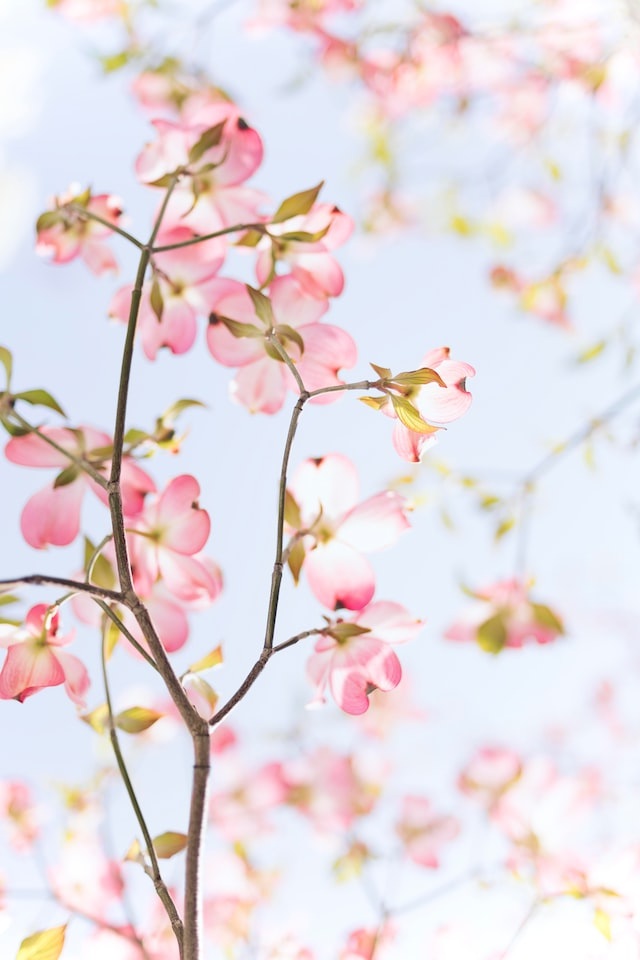The Dogwoods
This is an excerpt from the Book called ” Trees Shrubs & Hedges FOR YOUR HOME”. Continue reading to learn about The Dogwoods,thanks to the author.
Cornus
The dogwood is an almost perfect flowering tree that provides year-round beauty in the garden. In mid-spring, the dogwood bears dazzling white or pink 3-to 5- inch star-shaped “flowers,” which are pointed bracts that surround the trees true but inconspicuous green flowers. In fail, the foliage turns red to plum-colored, and the tree’s bright red berries attract birds.

The popular flowering dogwood (Cornus florida) is still the classic choice for northern gardens. This lovely ornamental can reach 40 feet. But if the tree is stressed, as it would be growing in cities, for example, it tends to develop problems.
Increasingly, flowering dogwood is being replaced by resistant Kousa, or Chinese, dogwood (C.Kousa variety chinensis). The dangling fruit of the Kousa dogwood resembles a small strawberry, and the bark exfoliates attractively. Where Kousa dogwoods aren’t available, a resistant hybrid of the Kousa and Florida species, C. Χ rutgersensis, is used. The flowers of these dogwoods open on top of somewhat dropping branches and bloom for several weeks in early summer. The weeping Kousa varieties, ‘Elizabeth Lustgatren’ and ‘Weaver’s Weeping’, are breathtaking. There’s also a pink Kousa dogwood, ‘Satomi’. ‘Summer Stars’, an introduction by William Fleemer of the Princeton Nurseries, blooms into August sand has exceptionally long-lasting flowers.
The pacific, or mountain, dogwood (C. nuttallii) is native from British Columbia to southern California in Zones 6-9 and reaches 75 feet in cultivation. Native Americans once steeped its bark to make a potion for tearing fevers. In April, showy white bracts cover the tree; in fall, numerous clusters of orange-red fruits appear, and the foliage turns yellow and scarlet. The tree sometimes blooms again in August. The Pacific dogwood doesn’t grow well outside its native range and sis sold only through nurseries and plant societies that specialize in native West Coast plants. This big American native is sometimes mistaken for the giant dogwood of China and Japan (C. Controversa), a 30-to 40-foot tree in cultivation in Zone 5. The giant dogwood is highly valued by European gardeners but almost impossible to find commercially in America.
Less well known but much loved are they yellow flowered dogwoods. The evergreen dogwoods (C. capitata) from, China has glossy green leaves and large sulfur yellow followers followed by Crimson fruits. It grows to 40 feet and can be somewhat bushy. Also shrubby is the Yellow-flowered 20-to 25-foot Cornelian cherry (C. mas), widely planted in the Midwest. Its showy scarlet fruit ripens in July and attracts birds. People eat the fruit as well; through acidic in flavor, it was once grown as a food crop and used to make syrups and preserves. Cornelian cherry, hardy in Zones 4-8, comes in variegated forms.

Two shrub-size twiggy dogwoods are planted in Zones 2-8 for their bark’s winter color. The red-barked, or Tartarian, dogwood (C. alba), a multistemmed, vase-shaped shrub 8 to 10 feet tall, bears small white flowers in spring followed by blue-white berries in the fall. The leaves often turn reddish plum with late fall cold; in winter, the bark turns a vivid red. The cultivar ‘Sidebar’ is smaller than the species, and its fall color is a brilliant coral red.
The red-osier, or American, dogwood (C. sericea formerly C. stolonifera) is similar to C. alba and succeeds in Zones 2-7. It is tolerant of wet soils and is found in many northeastern and Midwestern gardens. The stems of the cultivar ‘Flagstoned,’ the golden-twig dogwood, turn a striking yellow. To encourage the greatest display of colorful branches, cut these shrubby dogwoods back in late winter to stimulate the growth of young shoots. Bunchberry (C. Canadensis) is a 6-inch evergreen sub shrub.
Culture: Plant a young, dormant, container-grown or balled-and-burlapped dogwood in early spring, and handle the rootball with care. Dogwoods prefer moist but well-drained somewhat acid soil, pH 5.0 to 6.5. They thrive in bright or dappled shade and full sun.

